Barbell exercises have been a cornerstone of strength training for decades, and for good reason. A quad workout with a barbell is one of your best choices to build bigger legs.
Now, I’ll be honest – I used to skip leg day more often than I’d like to admit. However, everything changed when I discovered the power of barbell quad exercises.
When you lift a heavy bar and perform a squat, lunge, or deadlift, you are not only working your quadriceps. You’re engaging your entire body, challenging your muscles and nervous system. This means increased muscle growth, better coordination, and strength.
Here, we’ll look at the best barbell exercises for your quads, how to do them safely and effectively, and how to add them to your training plan.
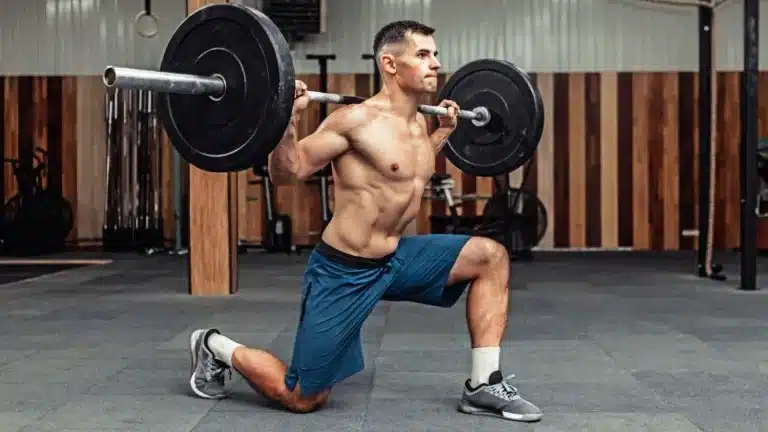
- 12 Best Quad Dominant Barbell Exercises To Build Mass
- 1. Barbell Squat
- 2. Barbell Front Squat
- 3. Barbell Forward Lunge
- 4. Barbell Split Squat
- 5. Barbell Step Up
- 6. Zercher Squat
- 7. Barbell Side Lunge
- 8. Barbell Bulgarian Split Squat
- 9. Barbell Hack Squat
- 10. Barbell Sumo Squat
- 11. Jefferson Squat
- 12. Barbell Box Squat
- Techniques To Build Quad with Barbell
- 1. Add Drop Sets
- 2. Supersets
- 3. Tempo Training
- 4. Progressive Overload
- 5. Barbell Focused Quad Workout Routine
- 6. Important Tips
- Quadriceps Muscle (Anatomy)
- 1. Rectus Femoris
- 2. Vastus Lateralis
- 3. Vastus Medialis
- 4. Vastus Intermedius
12 Best Quad Dominant Barbell Exercises To Build Mass
Let us explore the world of quad-barbell exercises and provide you with a comprehensive guide to maximizing leg gains.
We’ve got you covered with exercises like squats and lunges, as well as advanced ones like step-ups and hack squats.
Get ready to use your quads to their full potential and become stronger and more athletic.
1. Barbell Squat
The barbell squat is the king of all exercises, the only challenger being the barbell deadlift. Nothing comes close to squat workout to build muscle mass and tone the legs muscles.
The quadriceps femoris muscles are the primary active muscles during back squats. According to the study, the quadriceps muscle EMG activities were the highest during the back squat.
Most people love this exercise because it is great for strengthening the core and legs, shocking the body into releasing testosterone, and promoting the development of muscle mass and strength.
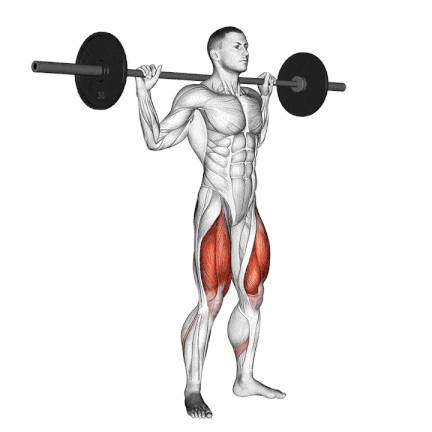
How To Do
- Step on the rack so that the barbell rests across the back of your shoulders.
- Raise the barbell and get away from the rack if you are doing with free weights.
- Bend your knees and lower yourself with your back straight.
- Now raise yourself up using only the thigh power.
- Keeping your back straight, in a position with legs nearly locked out.
Tips
- Start light and add weight gradually, allowing your legs and lower back to adapt.
- When lifting heavy weights, it is advised to have a spotter ready or to use a squat rack or power rack.
2. Barbell Front Squat
The barbell squat and the barbell front squat work the same target and synergistic muscles. However, the barbell front squat recruits more stabilizer muscles, including various back muscles, shoulders, and chest.
Front squats are perfect for Olympic weightlifters, athletes, bodybuilders, or anyone serious about their leg workouts. They’re excellent for quad and glute development and maintaining training intensity with less weight.
Plus, they offer great carryover benefits to other quad-dominant exercises like the back squat and leg press.
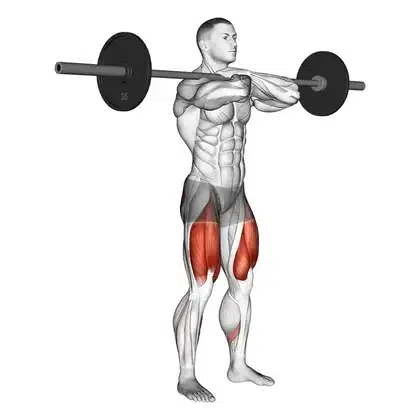
How To Do
- Step on a Smith machine and get the bar on your shoulders in front of you.
- Grasp it with your crossed arms and lift it off the rack.
- Maintain the natural arch in your lower back and keep your head directed forward.
- Bend your knees and drive your hips back to lower yourself until your thighs are parallel to the floor.
- From this position, push yourself back to the starting point.
3. Barbell Forward Lunge
The barbell lunge is a brilliant exercise to target the quadriceps, hamstrings, and glutes. It also engages the core muscles and helps improve balance and stability.
It helps to develop balance, coordination, and your legs’ unilateral (one-sided) functional strength.
Advance Variation Of Barbell Lunge
- Jumping Lunges (switching legs mid-air)
- Lateral Lunges (stepping to the side instead of forward)
- Clock Barbell Lunges (stepping in different directions, like 12, 3, 6, and 9 o’clock)

How To Do
- Stand tall with your feet hip-width apart.
- Hold a barbell behind the neck and stand upright.
- Bend your knees and get them close to the floor.
- Pause briefly in the bottom position and push through your front foot to return to the starting position.
- Repeat the movement with the other leg.
- Alternating sides for the desired number of repetitions.
Tips
- Keep your chest lifted, shoulders back, and core engaged.
- Bend as far and low as possible without losing form.
- Ensure that your front knee does not extend beyond your toes.
- Keep your torso upright and your head facing forward.
4. Barbell Split Squat
Split squats provide a refreshing change of stimulus for your lower body muscles, which makes them a valuable alternative to regular lunges.
It is a good lower-body exercise that works one leg at a time.
It involves standing with one leg in front of you and the other leg extended behind you. The split squat exercise focuses on an up-and-down motion pattern.
The main difference between split squats and lunges:
- A lunge can be performed either forward or backward, and occasionally in both directions.
- During a split squat, the athlete’s foot stays still while moving up and down.
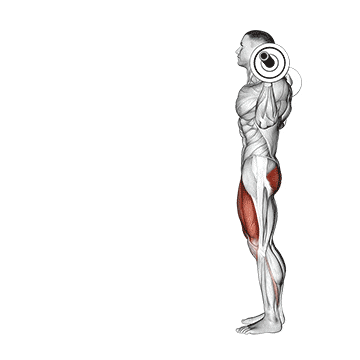
How To Do
- Place a barbell across your upper back, resting it on your upper traps.
- Ensure you have a firm grip on the barbell with your hands.
- Take a step forward with one leg, creating a split stance.
- The front foot should be positioned far enough in front to allow a 90-degree bend in both the front and back knees.
- Stand up straight and lower your body by bending your knees at the same time.
- Descend until your front thigh is parallel to the ground and your back knee is just above the floor.
- Pause briefly in the bottom position, then push through your front foot to return to the starting position.
- Repeat the movement with the opposite leg.
Tips
- Maintain an upright posture by bracing your abdominals and activating your core muscles.
- Don’t let your knee collapse inward or extend too far beyond your toes.
- Aim for a full range of motion by lowering until your front thigh is parallel to the ground
Read More To Know More: Barbell Leg Exercises For Strength And Power: A Complete Program
5. Barbell Step Up
The barbell step-up is a great exercise for building lower-body strength and power. This exercise targets the quadriceps and also involves calves and glutes & hip flexors.
The step-up is a great all-around exercise that is perfect for everyone. It can be modified to create a challenging workout for anyone, whether they have just started exercising or have been training for years.
It has a low risk of injury and, with a few adjustments, offers a good cardio and strength workout.
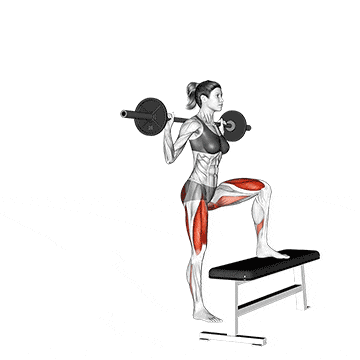
How To Do
- Place a knee-high box or bench in front of you and grasp a barbell supported on the back in each hand.
- Stand with your feet in a comfortable hip-width stance.
- Step forward with one leg onto the step and drive through that thigh to bring your body upward.
- Bring the trailing leg to the top of the step and stand on the box.
- Then step back with the opposite leg to the floor and lower yourself.
- Alternate legs with each rep. Repeat for the desired number of repetitions.
Tips
- Control the movement, using your muscles to lift and lower yourself slowly.
- Be sure to keep your lower back in its natural arch and your upper body upright throughout the movement.
- Keep your body upright and your feet and knees pointing in the same direction.
6. Zercher Squat
The Zercher squat, a demanding barbell exercise, is a staple in many advanced strength training programs. It loads highly on the anterior legs (Quads), upper back and traps, and the arms.
While beneficial, the Zercher squat is not suitable for beginners due to its technical difficulty and potential for injury if performed incorrectly.
However, for experienced lifters, it can be a valuable tool to enhance specific movement patterns, such as those seen in Strongman competitions or certain occupational activities.
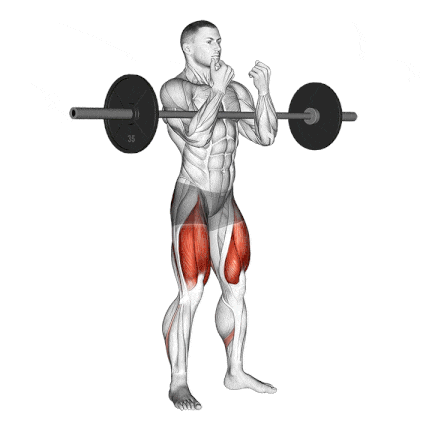
How To Do
- Stand with a shoulder-width grip while holding a barbell at chest height in the crook of your crossed arms.
- Carefully step backward from the rack and stand with a wide stance, with your knees and feet pointing out diagonally in the same direction.
- Keep your back straight and your body upright, and let your glutes move backwards to lower yourself.
- When your thighs are parallel to the floor, reverse direction and drive up through your heels into a standing position.
Tips
- Clasp fingers together while holding the barbell.
- Do not round your back. Keep your back straight with a natural arch in your lower back.
- Use elbow pads to decrease discomfort in your arms. Another option is placing two barbell pads for each arm on the bar.
7. Barbell Side Lunge
The side lunges (lateral lunges), are an effective exercise that targets the lower body. Specifically, they work the glutes, hamstrings, and quads. It also incorporates the inner thigh muscle.
If you are familiar with lunges, learning side lunges is a natural progression.
The unilateral movement of side lunges can help you to improve muscular imbalances, increase strength in each leg, and benefit from a functional movement.
Other Variations: Bodyweight Lateral Lunge and Dumbbell Lateral Lunge
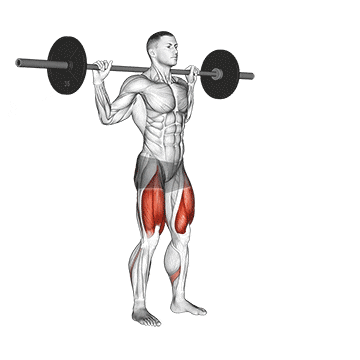
How To Do
- Place a barbell on your traps and stand with your feet about shoulder-width apart.
- Step out to your right as far as you can with your right foot.
- The forefoot should be turned out slightly as you plant it on the floor.
- Squat, shifting your weight to the left until your left leg is parallel with the floor.
- Extend your left leg back up to lift your body up.
- Repeat with your left leg in the same manner, alternating legs each rep until all reps are completed.
Tips
- Do not lean the torso forward as you rise out of the bottom of the lunge.
- Keep your bent knee aligned with your ankle to protect your knee joint.
8. Barbell Bulgarian Split Squat
The Bulgarian split squat is a classic lower-body exercise made popular by its challenging unilateral stance.
Because your rear foot is elevated and not in contact with the floor, you have effectively minimized its use. This means that you are relying heavily on the quadriceps of the forward leg to lift a significant portion of your weight.
If you suffer from balance problems, avoiding them or using your bodyweight variation while holding on to a steady object is best.
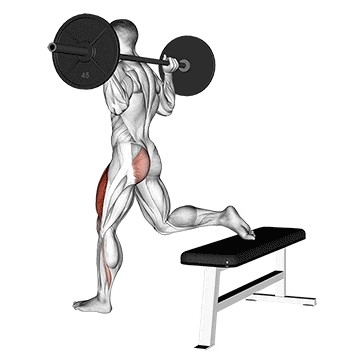
How To Do
- Start by standing in a split stance, with one foot positioned about two feet in front of the other.
- Your back foot should rest on a bench, box, or any elevated surface.
- Hold a barbell across your upper back, resting it on your trapezius muscles.
- Lower your body by bending your front knee and lowering your back knee towards the floor.
- Continue descending until your front thigh is parallel to the ground or slightly below.
- Push through your front heel and return to the starting position, extending your front knee and hip.
- Repeat the exercise with your opposite leg.
9. Barbell Hack Squat
The barbell hack squat is a variation of the traditional squat exercise.
Although the barbell hacks squat primarily focuses on the quadriceps, it also engages the hamstrings and glutes, promoting balanced lower body development.
It involves holding a barbell behind your legs while performing a squatting motion.

How To Do
- Stand with your feet shoulder-width apart and the barbell behind your legs.
- Squat down and grasp the barbell with an overhand grip.
- Keep your back straight, chest up, and head facing forward.
- Lift the barbell by extending your hips and knees to a standing position.
- Slowly lower yourself by bending at the knees and hips, as if sitting back into a chair.
- Continue lowering until your thighs are parallel to the ground or slightly below.
- Push through your heels and extend your knees and hips to return to the starting position.
Tips
- Ensure that your knees are in line with your toes.
- Warm up adequately before attempting this exercise
- Keep your core engaged and maintain a neutral spine
Know More: 12 Most Effective Smith Machine Leg Workout & Exercises
10. Barbell Sumo Squat
Barbell Sumo Squats are a compound exercise that primarily targets the muscles of the lower body, including the quadriceps, hamstrings, glutes, and adductors.
This variation of squats involves using a barbell and adopting a wide stance with the toes pointing outwards, similar to a sumo wrestler’s stance.
Using a wide stance to do this exercise can help you improve hip mobility and flexibility.
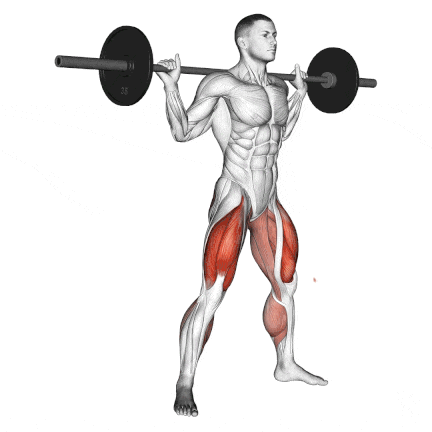
How To Do
- Stand with your feet wider than shoulder-width apart and your toes pointed outward at a 45-degree angle.
- Reach down and grip the barbell overhand, slightly wider than shoulder-width apart.
- Take a deep breath and brace your core.
- Push through your heels and pull your hips forward to start the motion.
- Extend your knees and hips simultaneously until you’re standing upright.
- Pause briefly at the top and squeeze your glutes.
- Then, slowly lower yourself back down by bending your knees and pushing your hips back.
- Continue squatting until your thighs are parallel to the floor or slightly below.
11. Jefferson Squat
Jefferson squats are an old technique that few people utilize anymore, but they truly are an excellent workout because they test and work your lower body.
It requires a balancing act (Asymmetrical movement), and there’s an element of building up coordination and stabilization to keep the bar centered, which also helps to avoid injuries.
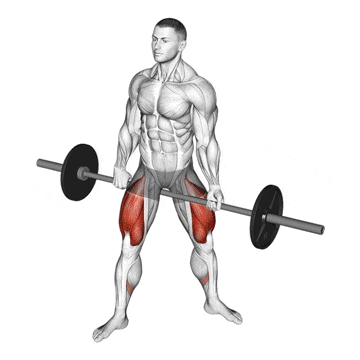
How To Do
- Straddle a loaded barbell placed on the floor and running sideways between your feet.
- Squat down to pick up the bar, grabbing it with one and facing palm backward and one hand facing palm forward.
- Hold the bar as you stand with a wider grip than shoulder-width.
- Bend at the knees and hips, letting your glutes track backward to lower yourself.
- When your thighs are parallel to the floor or the bar touches the floor, reverse direction, driving up forcefully through your heels to a standing position.
Tips
- Keep your feet flat, your chest up, your back straight, and your shoulders back.
- Ensure that the weight is evenly distributed between your two legs.
- Hold the barbell with an even, well-balanced grip.
12. Barbell Box Squat
The box squat is a compound exercise that uses a barbell and plyometric box to work for muscle groups throughout your body.
Box squats puts slightly less pressure on your knee joints when compared to front squats or back squats.
This is a great workout for learning how to squat because it reinforces the sitting-back portion of the squat.
Other variation: Bodyweight Box Squat and Dumbbell Box Squat
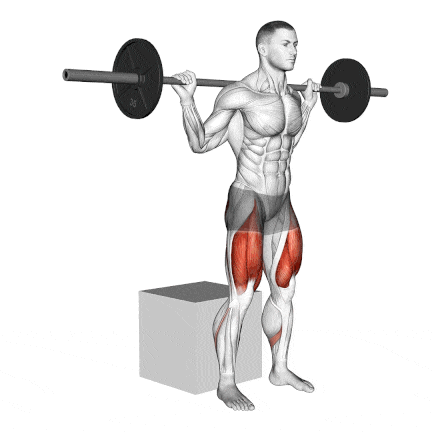
How To Do
- Place a box or bench that is about knee height behind you in the power rack or squat rack.
- Unrack the bar and move back so you are several inches ahead of the box or bench.
- Your posture should be tall, with your feet wider than hip-width apart and your knees slightly bent.
- Your shoulders should be directly over your hips, with your head and neck in a neutral position.
- Squat back and down until your glutes contact the box, and immediately explode back up by pressing through your heels until you’re back in the standing position. Do not “plop” or fully sit down on the box.
Tips
- As you stand, keep your chest high and squeeze your glutes
- The goal is to squat slowly and softly on the box and immediately explode.
- Do not sit on the box and rock backward, as this can compress the spine; just pause and immediately raise.
Techniques To Build Quad with Barbell
Once you’ve mastered the basics of barbell exercises for quad development, you can incorporate advanced techniques to take your quad-building to the next level.
Here are some techniques to consider:
1. Add Drop Sets
Drop sets involve performing a workout with a heavy load, immediately reducing the load, and performing the same workout with a lighter load.
This technique can help you push past plateaus and increase muscle growth.
2. Supersets
Supersets involve performing two exercises back-to-back with no rest in between. This technique can increase muscle activation and promote muscle growth.
3. Tempo Training
Manipulate the tempo of your reps to increase time under tension. For example, perform slow and controlled eccentric and concentric movement phases, emphasizing the lowering and lifting portions.
By increasing muscle fiber recruitment, this technique can lead to significant quad hypertrophy.
4. Progressive Overload
Progressive overload involves gradually increasing an exercise’s weight or resistance over time. It can help you build strength and muscle mass.
5. Barbell Focused Quad Workout Routine
| Exercise | Sets | Reps | Rest Time |
|---|---|---|---|
| Barbell Squats | 3-4 | 8-10 | 2-3 minutes |
| Barbell Lunges | 3 | 10-12 | 1-2 minutes |
| Barbell Bulgarian Split Squats | 3 | 8-10 (each leg) | 1-2 minutes |
| Barbell Step-Ups | 3 | 10-12 | 1-2 minutes |
| Barbell Hack Squats | 3 | 8-10 | 1-2 minutes |
6. Important Tips
To minimize your risk of injury, make sure to follow these safety precautions:
- Always warm up properly before lifting
- Start with a weight that is manageable for your fitness level
- Use a spotter when lifting heavy weights
- Focus on proper form throughout each exercise
- Listen to your body and stop if you experience any pain or discomfort
Quadriceps Muscle (Anatomy)
The quadriceps, commonly called the quads, are a group of four large muscles located on the front of the thigh. These muscles work together to extend the leg and flex the hip joint.
Understanding the anatomy of the quadriceps can help target and train these muscles effectively.
The four main muscles that make up the quadriceps are:
1. Rectus Femoris
- The rectus femoris is the largest and most superficial muscle of the quadriceps.
- It originates from the anterior inferior iliac spine (part of the hip bone) and the upper part of the acetabulum (hip joint socket).
- It runs down the thigh, inserts into the patella (kneecap), and then continues as the patellar tendon attaches to the tibia (shinbone).
2. Vastus Lateralis
- Largest and most lateral (outer) muscle of the quadriceps.
- It originates from the greater trochanter of the femur (bony prominence on the side of the hip) and the linea aspera (ridge on the back of the femur).
- It runs down the thigh and inserts into the outer part of the patella and the tibial tuberosity (bump on the front of the tibia).
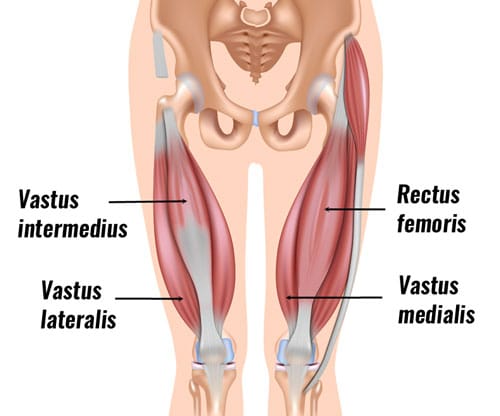
3. Vastus Medialis
- Located on the medial (inner) side of the quadriceps muscle group.
- It originates from the intertrochanteric line (ridge on the hip’s inside) and the femur’s linea aspera.
- It runs down the thigh and inserts into the inner part of the patella and the tibial tuberosity.
4. Vastus Intermedius
- Located deep within the quadriceps muscle group.
- It originates from the anterior and lateral surfaces of the femur.
- It runs down the thigh and merges with the other quadriceps muscles to insert into the patella and tibial tuberosity.
References
- Hagen Hartmann, Klaus Wirth, and Markus Klusemann, ‘Analysis of the Load on the Knee Joint and Vertebral Column with Changes in Squatting Depth and Weight Load’, in Sports Medicine, (2013, Vol.43), pp.993-1008
- Myer GD, Kushner AM, Brent JL, Schoenfeld BJ, Hugentobler J, Lloyd RS, Vermeil A, Chu DA, Harbin J, McGill SM. The back squat: A proposed assessment of functional deficits and technical factors that limit performance. Strength Cond J. 2014 Dec 1;36(6):4-27. doi: 10.1519/SSC.0000000000000103. PMID: 25506270; PMCID: PMC4262933.

Manish is a NASM-certified fitness and nutrition coach with over 10 years of experience in weight lifting and fat loss fitness coaching. He specializes in gym-based training and has a lot of knowledge about exercise, lifting technique, biomechanics, and more.
Through “Fit Life Regime,” he generously shares the insights he’s gained over a decade in the field. His goal is to equip others with the knowledge to start their own fitness journey.
